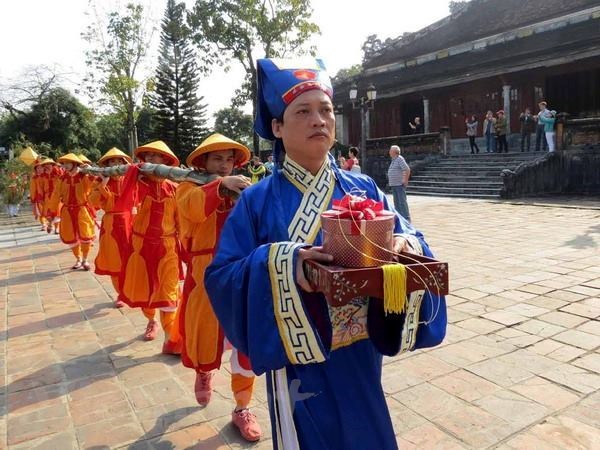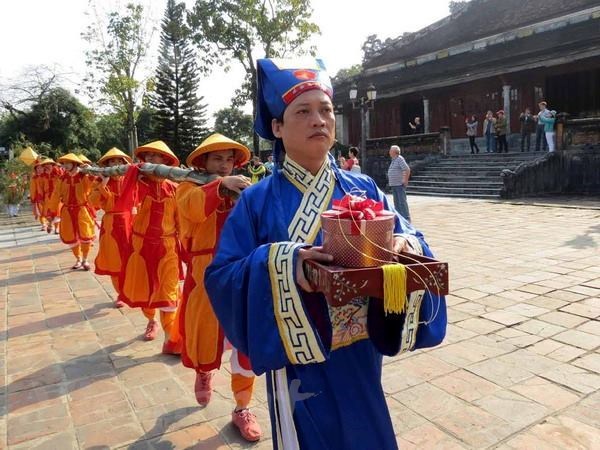
A ceremony to plant Neu pole (a tall bamboo tree with red garment strips used to ward off evil spirits during Tet) was organised at Hue Imperial Citadel in the central province of Thua Thien-Hue on February 8.

Neu pole
erected at Hue Imperial Citadel - Illustrative image (Source: VNA)
The 15-metre bamboo pole was carried by a group of men dressed as soldiers
under the Nguyen Dynasty in a procession from the Hien Nhon Gate through the
Thai Hoa Palace to arrive at the Ancestral Temple, where it was erected.
The erection of the Neu pole on the 23rd day of the 12th lunar month marks the
beginning of Tet. It coincides with the day when the Kitchen Gods are believed
to ride carp fish to the Heaven to report on events from the past year.
During 143 years of reign (1802 – 1945), the Nguyen Dynasty held an annual
ceremony to plant the Neu pole at the Imperial Citadel. The pole carries ritual
items on its top, like a royal seal, a paper scroll and pen, which imply that
the royal court stopped working during Tet.
The Neu pole is also believed to ward off ghosts and demons from entering the
community during Tet. It would also direct ancestors seeking the path home for
the Lunar New Year holiday. The custom is also practised in some Asian
countries besides Vietnam.
It will be taken down on the seventh day of the first lunar month to mark the
end of the Tet celebration.
Also on the day, the Hue Relics Preservation Centre held a Tet programme, which
offers visitors a chance to listen to nha nhac (Hue royal court music), folk
games, and watch a competition to make Chung cake (a cake made from glutinous
rice traditionally dedicated to Tet).
Source: VNA
Xoe dance, an unique art form of the Thai ethnic minority group in Mai Chau district of Hoa Binh province has existed for a long time and passed down through generations. Xoe dance is not only a popular dance in the Thai community but also a unique cultural feature, an indispensable part in the Thai ethnic minority people's cultural and spiritual life.
The Bac Son pre-school in Hung Son commune, Kim Boi district is effectively implementing a model of preserving and promoting cultural identity of the Muong ethnic group.
Through ups and downs, many unique cultural features of the Muong ethnic minority group are facing risks of falling into oblivion. However, with a strong determination, Lac Son district of Hoa Binh province has deployed synchronous solutions to preserve and promote the locality's cultural heritage values.
If Tan Lac is considered the core of the cradle of Muong culture in Hoa Binh, Phong Phu commune is the cultural centre of Muong culture in Tan Lac district. Luy Ai hamlet in Phong Phu commune is where customs and traditions of Muong Bi are preserved. Luy Ai hamlet was chosen to build a space to preserve Muong ethnic culture. The district is seeking support from the province and coordinating with relevant agencies to devise a plan on preservation of Muong cultural spaces associated with developing tourism products and improving the lives of local residents.
Nguyen Manh Tuan, a Muong ethnic man in Ba Hang Doi town, Lac Thuy district, is known as a young, dedicated, and outstanding artisan who has made significant contributions in collecting, restoring, and preserving national cultural values.
The Government Office with Document No. 2082/VPCP-KGVX, dated March 29, 2024, sent out the opinion of Deputy Prime Minister Tran Hong Ha regarding the submission of the "Mo Muong" and "Cheo art" dossiers to the United Nations Educational, Scientific and Cultural Organization (UNESCO).



